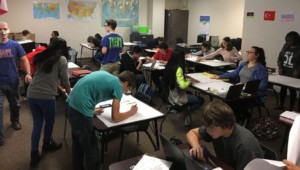How to Promote College Readiness: A Washington State Case Study

By Tom Vander Ark & Mary Ryerse
Since 2005, College Spark Washington (CSW) has awarded more than $50 million to college readiness and degree completion programs. Like Lumina, KnowledgeWorks and Nellie Mae, CSW was funded with the proceeds from student loan sales. In partnership with Washington State, CSW invested $9.5 million in 2006 to fund a nine-year College Readiness Initiative (CRI).
Six-year grants were provided to 39 low-income schools in an effort to prepare more students for college and career. The results were promising and informative: course taking patterns and achievement improved, and high school graduation and college enrollment rates improved.
Ranging from urban to rural, the 39 low-income grantee schools (16 high schools, 19 middle schools and 4 combination schools) from 13 districts received funding to implement a career readiness initiative, which includes advisory curriculum, student-led conferences and personal learning plans, a program called Navigation 101 (now Career Guidance Washington or CGW) and AVID. Schools could also apply for additional funds to increase dual credit access and success through programs such as Advanced Placement, Project Lead the Way and College in the Schools.
All students in Career Guidance Washington experience the following:
- Advisory: 1:1 relationship to personalize readiness
- Curriculum: Projects promoting college, career and life readiness
- Personalized Learning Plan and Portfolio: Focused on strengths, goals and action steps
- Student-Led Conferences: To share progress, goals, and plans
- Student-Driven Scheduling: To ensure transcript readiness
- Data and Evaluation: Ongoing metrics
Transcript Data. At the beginning of the initiative, CGW school data around transcript readiness indicated that on average only 37 percent of students had a college-ready transcript. Considering that all CGW schools are classified as low-income (with some up to 99 percent free or reduced lunch), this starting point is very similar to data from the Education Trust’s Meandering Toward Graduation report, which shows that only three out of 10 low-income students complete a college-ready course of study.
However, by the end of the grant, 56 percent of students achieved college-ready transcripts, with even greater gains and gap-closing amongst certain populations.
 Graduation Rates. CGW graduation data speaks for itself. In CGW grant-funded schools, graduation rates were 20 percent points higher on average than in comparable schools. Some individual schools showed even more remarkable gains. For example, Rogers High School in Spokane showed a graduation rate increase of 34 percentage points between 2008 and 2014.
Graduation Rates. CGW graduation data speaks for itself. In CGW grant-funded schools, graduation rates were 20 percent points higher on average than in comparable schools. Some individual schools showed even more remarkable gains. For example, Rogers High School in Spokane showed a graduation rate increase of 34 percentage points between 2008 and 2014.
Dual Enrollment. Between the 2010-2011 and 2013- 2014 school years, the number of students earning dual credit showed a 31 percent increase (from 2,811 to 3,772 students) and the total number of dual credits earned almost doubled (nearly an 80 percent increase from 6,192 to 11,141 credits). In total, the average number of credits per student went from just above two to almost three. Not only are more students earning dual credits, but on average each student is earning more credits.
College Enrollment. While national data showed that college enrollment for low-income students decreased significantly from 2008 to 2013 (over 10 percent), CGW schools did the opposite–college enrollment rates for low-income students at CGW schools increased from 43 percent in 2008 to 56 percent in 2013.
The state made the CGW program available to all schools, and usage grew to more than 500 middle and high schools across the state during the College Readiness Initiative.
In addition to significant improvement at grantee schools and statewide access to a guidance platform, the CRI resulted in better understanding of an integrated approach to college, career and life readiness.
To learn more about the need for readiness, the story of the high-impact Career Guidance Washington program and how partnerships can enhance college, career and life readiness initiatives, read our first paper in a two-part series An Integrated Approach to College, Career & Life Readiness and be sure to also check out the accompanying infographic Every Student Deserves a Champion.
This blog is part of a content series produced in partnership with College Spark Washington (@CollegeSparkWA). Join the conversation on Twitter using #CollegeReady or #RedefiningReady. To learn more about Integrating Readiness:
| Theme | College, Career & Life Readiness | Academic and Social Supports |
| White Paper | An Integrated Approach to College, Career & Life Readiness: A Case Study on Personalizing Guidance | An Integrated Approach to Academic & Social Supports: A Case Study on Increasing Access through AVIDTo be released May 2017 |
| Infographic | Every Student Deserves a Champion | Academic and Social Supports Drive Student SuccessTo be released May 2017 |
| Featured Program |
CGW (@waOSPI) personalizes guidance and provides a student-centered approach to college, career and life readiness by helping students understand who they are, where they’re headed and how they’ll get there.
|
The AVID (@AVID4College) program provides strong academic and social supports that prepare students for college and create a school-wide culture of college readiness.
|
For more, see:
- 11 Essentials For Maximum Impact on Student College Prep Success
- The Three Keys to College Persistence
- Smart List: 50 Organizations Boosting College Access & Success










0 Comments
Leave a Comment
Your email address will not be published. All fields are required.